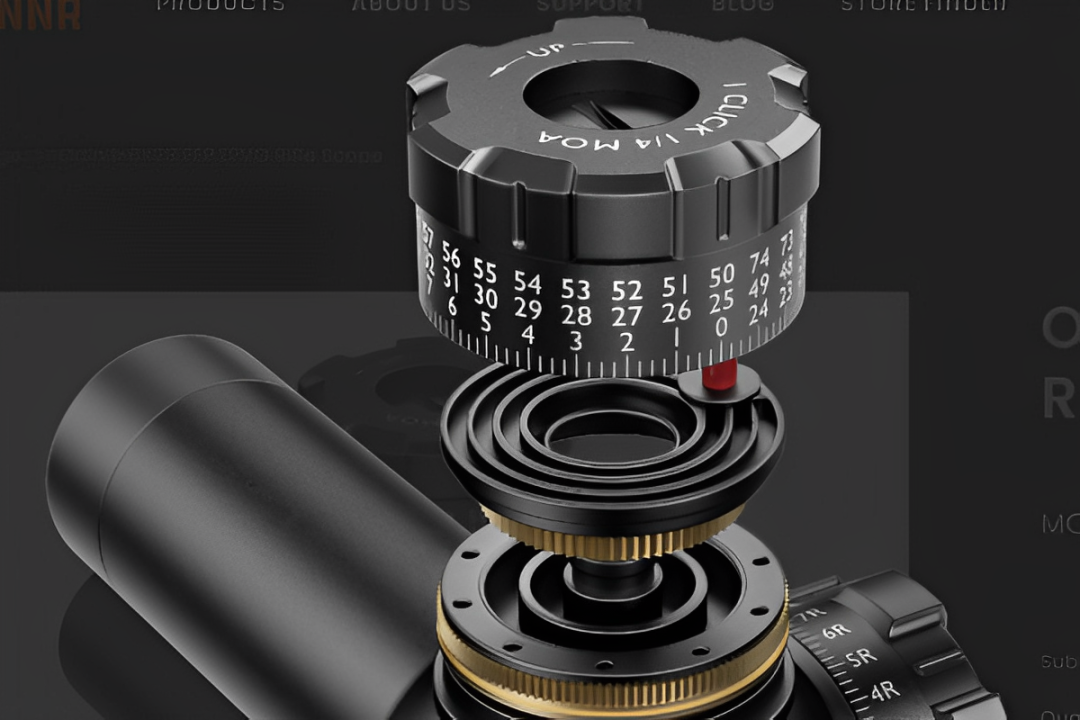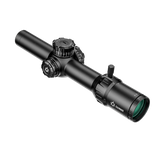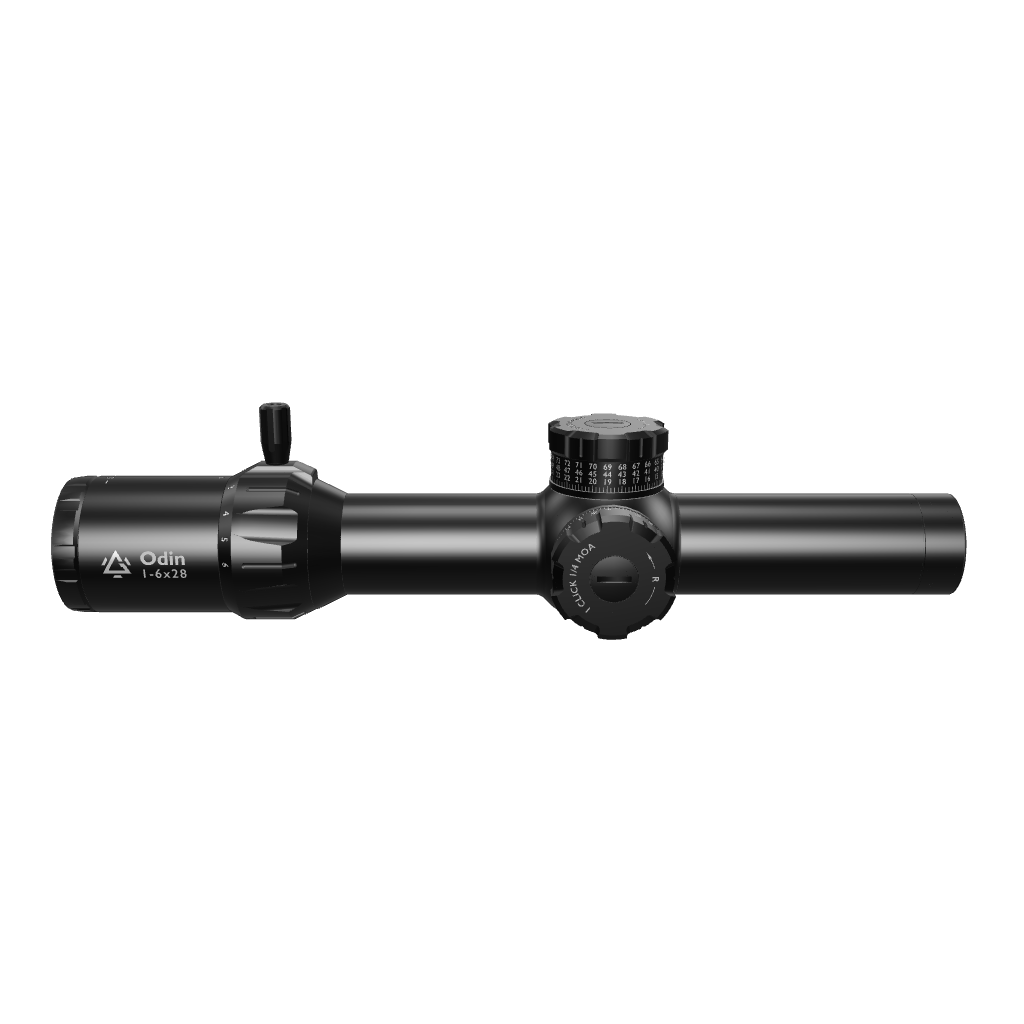How to Read Scope Numbers
The numbers on a scope give you important information about the scope, such as magnification range, reticle size, and adjustment values.
Knowing how to read scope numbers will help you understand how your rifle scope works, how to make precise adjustments, and how to determine, at first glance, if a scope fits your shooting needs.
Here's a breakdown of what those scope numbers mean and how to read them:

1. Reading Scope Magnification (Zoom Range)
The first numbers you’ll typically see on a scope represent its magnification range and the diameter of the objective lens.
Take, for example, a scope labeled 1-6x28. Here’s how to read these numbers:
- “1-6x” is the zoom range, indicating that the scope has a variable magnification that can be adjusted from 1x (minimum magnification) to 6x (maximum magnification).
- “28” refers to the diameter of the objective lens in millimeters.
So, here is what the scope numbers 1-6x 28 tell you about this scope:
Not all scope numbers are the same. For fixed magnification scopes, the numbers indicating the magnification range are shorter, with no hyphens.
If you see something like 4x32, the 4x means the scope is fixed at 4x magnification (it can't zoom in or out), and the 32 refers to the objective lens diameter.
Tips For Interpreting Scope Numbers
- A higher magnification (e.g., 9x) will help you see smaller details at longer distances.
- A lower magnification (e.g., 1x) gives you a wider field of view, making it easier to track moving targets.
- Hunting scopes usually have higher magnification, while tactical scopes like LPVOs have mid-range to lower magnification

2. Objective Lens Size (mm)
The second number after the magnification range (like 28 in 1-6x28) refers to the diameter of the objective lens (the lens at the front of the scope).
Here’s why the size of the objective lens matters:
- A larger lens means more light enters the scope, which improves image brightness and clarity, especially in low-light conditions.
- A smaller objective lens makes for a more compact scope, lighter and easier to carry about, but might offer a slightly dimmer image, especially at higher magnifications
For example, a 1-8x28 scope will gather more light, providing a clearer image in dim light conditions than a 1-8x24 scope, but it might be slightly larger and just a little heavier.
3. Turret Adjustments (MOA or MIL)
The numbers on scope turrets (commonly known as markings) usually come in one of two types: MOA (Minute of Angle) or MIL (Milliradian).
These are the scope numbers used to adjust your point of impact—either for elevation (up and down) or windage (left and right).
So, it is important to learn how to read them.

a) MOA (Minute of Angle)
MOA means “Minute of Angle, and it is a unit of angular measurement used to describe how much adjustment you make with each click of the turret.
- At 100 yards, 1 MOA equals 1.047 inches
MOA in shooting
In a typical scope, one click of the turret might adjust the point of impact by 1/4 MOA (0.25 inches at 100 yards). Some scopes may have 1/2 MOA (0.5 inches at 100 yards) or other increments.
- If your scope has 1/4 MOA adjustments and you make 4 clicks, you will have moved the point of impact by 1 inch at 100 yards.
MOA is great for long-range shooters, especially for targets 200 yards and beyond, as it helps with precise adjustments.
b) MIL (Milliradian)
MIL stands for “milliradian”, another form of angular measurement that lets you figure out your scope adjustments.
1 MIL equals 3.6 inches at 100 yards or 10 cm at 100 meters.
- Many MIL-based scopes will adjust 1/10 MIL per click. So, a full MIL adjustment (10 clicks) would shift your point of impact by 3.6 inches at 100 yards.
A milliradian is 1/1,000th of a radian.
Here are 4 important things to know about Milliradian
- At 100 yards, 1 mil is approximately 3.6 inches.
- It is also an angular unit of measurement. Again, this means it spreads out over a distance.
- At 200 yards, 1 Mil equals 7.2 inches; at 300 yards, it equals 10.8 inches, and so on.
- Scope Adjustments are usually standard with Mil. Mil optics commonly adjust in 0.1 Mil increments.
- If your scope has 1/10 MIL adjustments, making 5 clicks would move your point of impact by 1.8 inches at 100 yards (since 1 MIL = 3.6 inches, 1/10 of that is 0.36 inches per click).
- MOA vs MIL
MOA is often preferred for those who want easier, more intuitive adjustments (1 MOA = ~1 inch at 100 yards).
MIL is often used by military and tactical shooters because it provides a more precise system, especially for long-range shooting.
5. Reticle Types (MOA vs. MIL)
MOA reticles typically have marks or dots that correspond to MOA values, allowing you to use the reticle itself for windage and elevation adjustments without using the turrets.
MIL Reticles may have hash marks and holdover points designed for milliradians, which correspond directly to the MIL adjustment system on your turrets.
Example
A MIL-dot reticle might have horizontal and vertical lines that are spaced 1 MIL apart. When you're shooting at long ranges, you can estimate holdovers and windage based on these markings

4. Parallax Adjustment
Rifle scope parallax is a visual effect that occurs when the reticle (crosshairs) of your scope and the target are not perfectly aligned on the same focal plane.
This misalignment, no matter how small, causes the reticle to appear to shift relative to the target when you move your head behind the scope.
The result is that your point of aim becomes inaccurate, and the greater the distance between yourself and the target, the more inaccurate your aim gets.
Common Parallax Markings
The parallax knob might have markings like 50 yards, 100 yards, 200 yards, etc., showing the distance at which parallax is corrected.
If you’re shooting at 100 yards and your scope has a parallax adjustment, you’ll set it to 100 yards to ensure that your reticle and target stay in perfect focus no matter where you position your eye.
6. Other Key Scope Numbers
i. Field of View (FOV)
You might see numbers like 40 ft @ 100 yards or 10m @ 100m. These indicate how wide the view is at a specific distance. A larger FOV is better for fast-moving targets or target tracking.
ii. Eye Relief
This is the distance from the rear lens of the scope to your eye. It’s usually marked as something like 3.5 inches.
The longer the eye relief, the more flexibility you have in mounting the scope and adjusting your head position without losing sight of the reticle.

Summary of Scope Numbers and What They Mean
Let’s wrap this up with a quick summary:
- Magnification (e.g., 3-9x): Tells you the zoom range. Higher magnification = greater detail at longer distances.
- Objective Lens (e.g., 40mm): The diameter of the front lens. Larger = better light-gathering, but a bulkier scope.
- Turret Adjustments (MOA or MIL): The value per click. MOA = inches at 100 yards, MIL = centimeters or inches at 100 meters or yards.
- Parallax Adjustment: Used to eliminate parallax error, which keeps your reticle and target aligned when shifting eye position.
- Reticle Type: Some reticles are calibrated for MOA, others for MIL, allowing you to use them for holdover or windage adjustments.
Final Thoughts: Scope Numbers Tell You Everything
The numbers tell you more than just magnification and lens size—they provide the framework for precise shooting, windage adjustments, and accurate holdovers.
Whether you’re hunting, target shooting, or competing in long-range competitions, mastering the scope numbers will significantly improve your shooting experience.







